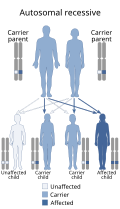Progeroid syndromes
Progeroid syndromes are a group of rare genetic disorders which mimic physiological aging, making affected individuals appear to be older than they are. The two most well-known types of progeroid syndromes are Hutchinson-Gilford Progeria Syndrome (HGPS) and Werner syndrome.
Overview[edit]
Progeroid syndromes are characterized by the early onset of diseases associated with old age. The term "progeroid" is derived from the Greek words "pro" (meaning "before") and "geras" (meaning "old age"). These syndromes are often considered to be segmental, as they do not affect all aspects of aging, but rather focus on certain areas.
Types of Progeroid Syndromes[edit]
There are several types of progeroid syndromes, including:
- Hutchinson-Gilford Progeria Syndrome (HGPS)
- Werner syndrome
- Cockayne syndrome
- Rothmund-Thomson syndrome
- Bloom syndrome
Symptoms[edit]
The symptoms of progeroid syndromes can vary greatly depending on the specific syndrome, but may include:
- Premature aging
- Growth retardation
- Hair loss
- Skin abnormalities
- Cataracts
- Osteoporosis
- Cardiovascular disease
Causes[edit]
Progeroid syndromes are caused by mutations in specific genes. For example, HGPS is caused by a mutation in the LMNA gene, while Werner syndrome is caused by a mutation in the WRN gene.
Diagnosis[edit]
Diagnosis of progeroid syndromes is based on clinical features, genetic testing, and in some cases, biopsy of affected tissues.
Treatment[edit]
There is currently no cure for progeroid syndromes. Treatment is supportive and aims to manage symptoms and improve quality of life.
See Also[edit]
References[edit]
<references />
Ad. Transform your life with W8MD's Budget GLP-1 injections from $75


W8MD offers a medical weight loss program to lose weight in Philadelphia. Our physician-supervised medical weight loss provides:
- Weight loss injections in NYC (generic and brand names):
- Zepbound / Mounjaro, Wegovy / Ozempic, Saxenda
- Most insurances accepted or discounted self-pay rates. We will obtain insurance prior authorizations if needed.
- Generic GLP1 weight loss injections from $75 for the starting dose.
- Also offer prescription weight loss medications including Phentermine, Qsymia, Diethylpropion, Contrave etc.
NYC weight loss doctor appointmentsNYC weight loss doctor appointments
Start your NYC weight loss journey today at our NYC medical weight loss and Philadelphia medical weight loss clinics.
- Call 718-946-5500 to lose weight in NYC or for medical weight loss in Philadelphia 215-676-2334.
- Tags:NYC medical weight loss, Philadelphia lose weight Zepbound NYC, Budget GLP1 weight loss injections, Wegovy Philadelphia, Wegovy NYC, Philadelphia medical weight loss, Brookly weight loss and Wegovy NYC
|
WikiMD's Wellness Encyclopedia |
| Let Food Be Thy Medicine Medicine Thy Food - Hippocrates |
Medical Disclaimer: WikiMD is not a substitute for professional medical advice. The information on WikiMD is provided as an information resource only, may be incorrect, outdated or misleading, and is not to be used or relied on for any diagnostic or treatment purposes. Please consult your health care provider before making any healthcare decisions or for guidance about a specific medical condition. WikiMD expressly disclaims responsibility, and shall have no liability, for any damages, loss, injury, or liability whatsoever suffered as a result of your reliance on the information contained in this site. By visiting this site you agree to the foregoing terms and conditions, which may from time to time be changed or supplemented by WikiMD. If you do not agree to the foregoing terms and conditions, you should not enter or use this site. See full disclaimer.
Credits:Most images are courtesy of Wikimedia commons, and templates, categories Wikipedia, licensed under CC BY SA or similar.
Translate this page: - East Asian
中文,
日本,
한국어,
South Asian
हिन्दी,
தமிழ்,
తెలుగు,
Urdu,
ಕನ್ನಡ,
Southeast Asian
Indonesian,
Vietnamese,
Thai,
မြန်မာဘာသာ,
বাংলা
European
español,
Deutsch,
français,
Greek,
português do Brasil,
polski,
română,
русский,
Nederlands,
norsk,
svenska,
suomi,
Italian
Middle Eastern & African
عربى,
Turkish,
Persian,
Hebrew,
Afrikaans,
isiZulu,
Kiswahili,
Other
Bulgarian,
Hungarian,
Czech,
Swedish,
മലയാളം,
मराठी,
ਪੰਜਾਬੀ,
ગુજરાતી,
Portuguese,
Ukrainian






